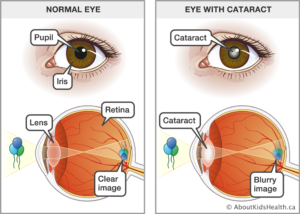Cataract Care!
What is a cataract?
A cataract forms when the lens within the eye becomes dense and cloudy, often due to normal age-related changes. The early stages of cataract formation can begin as early as age 40, though cataract formation in children is possible. Most times cataracts develop slowly, causing small progressive changes in vision. Once the cataract becomes prominent enough, it must be surgically removed.
Common symptoms of cataracts include: blurred vision, ghosting of images, dulling of colors, and halos or troubles with glare (which is often noticeable during nighttime driving). Changes in cataracts can cause shifts in the glasses prescription. At some point, the cataract will become cloudy enough that prescription changes are no longer able to account for changes in the cataract and sharpen vision — when this occurs, the cataract must be removed.

What causes cataracts?
The most frequent cause of cataracts are age-related metabolic changes within the lens. Exposure to UV light can also cause cataracts — for this reason, it is important to protect your eyes against UV light using a good pair of sunglasses. Sunglasses must offer 99% or more UV protection (not all sunglasses are made equally!). Other causes of cataracts are smoking, eye injuries, and certain medications, such as corticosteroids. Think you may have a cataract? Schedule an appointment with us today!
Can cataracts be treated?
Although there is no cure for cataracts, they can be surgically removed. During surgery, the cataract is broken up and taken out. It is then replaced by a clear lens implant. Cataract surgery is one of the most commonly performed eye surgeries.
There are several different types of implants on the market today, which can be used to replace all or part of your old glasses prescription. Some of these implants correct for astigmatism, or they can be used to correct vision for multiple distances (like a bifocal). These options are all discussed prior to cataract surgery referral.
Can cataracts come back after they are removed?
No. Once a cataract is removed, it is replaced by a clear implant. After this point, a cataract cannot form again.
It is important to note that in around 50% of patients, some cells may collect on the back layer of the bag the holds the implant in place. Patients that experience this may notice symptoms similar to when they first had cataracts, including blurred vision, ghosting images, and troubles with glare. Removal of this cell layer is very simple — all that is required is a simple laser procedure to remove this layer of cells once and for all.
Call us at 260-726-4210 to schedule an appointment for your cataract evaluation!
